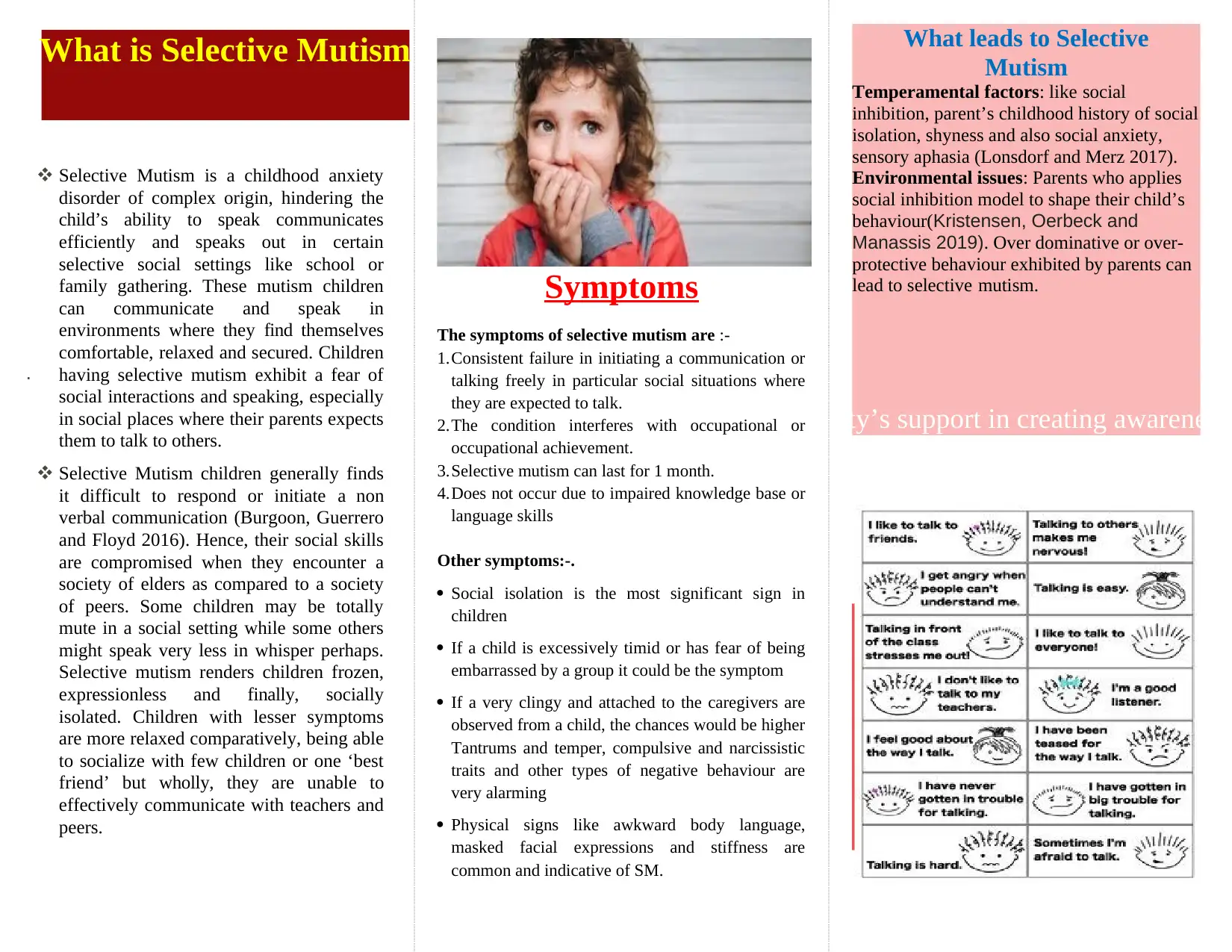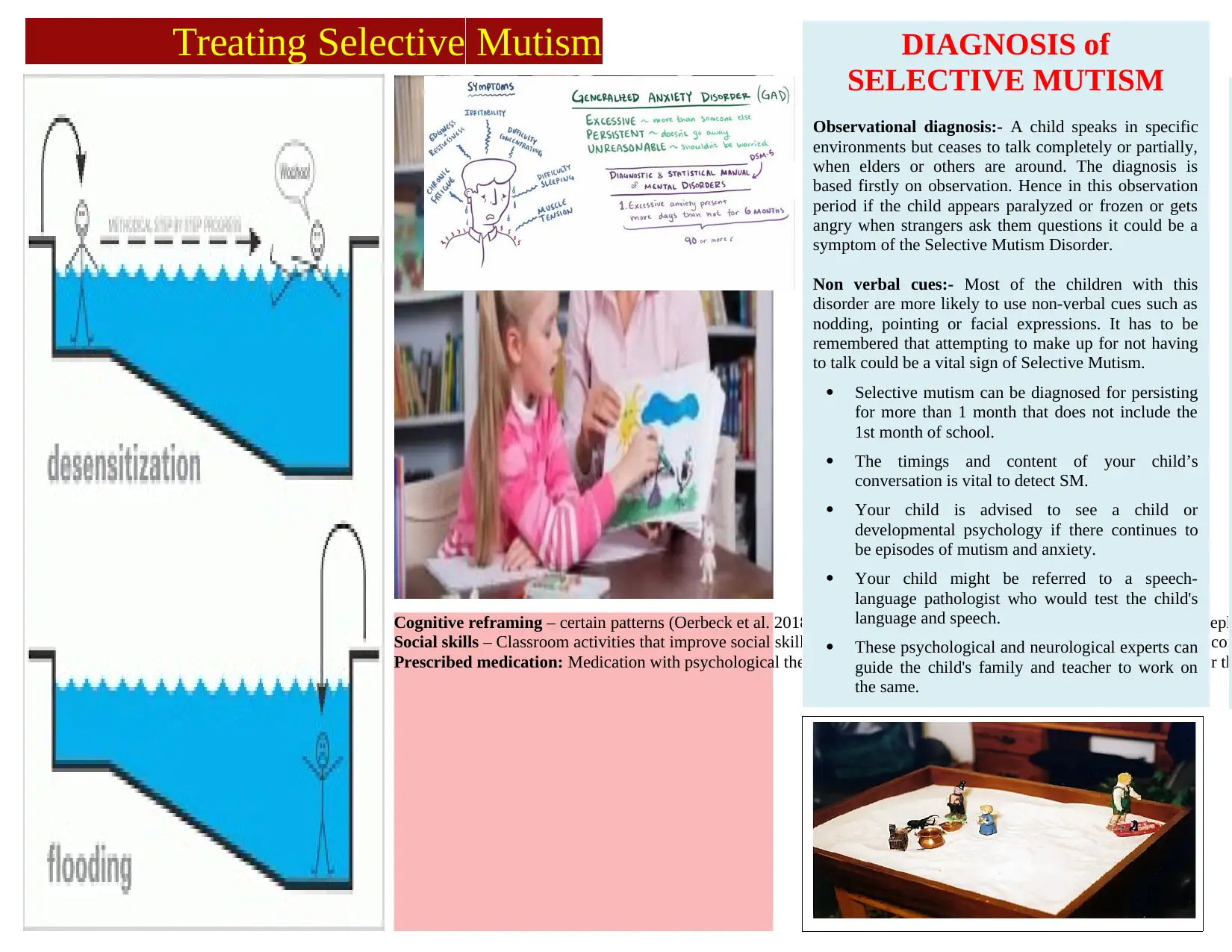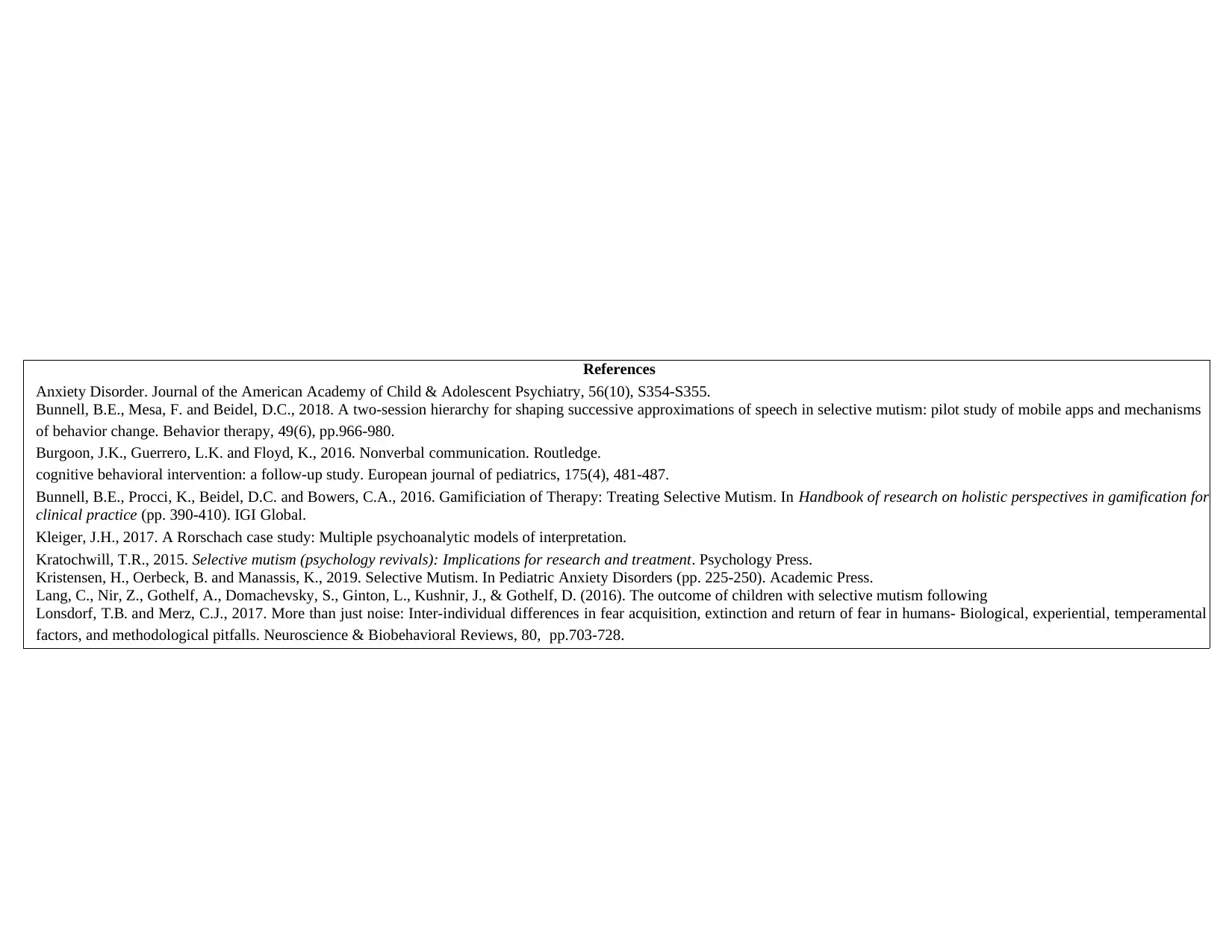Comprehensive Report on Selective Mutism: Symptoms, Causes, Treatment
VerifiedAdded on 2023/04/12
|3
|865
|485
Report
AI Summary
This report comprehensively addresses selective mutism, a childhood anxiety disorder characterized by the inability to speak in specific social situations. It details the symptoms of selective mutism, including consistent failure to initiate communication, interference with occupational or academic achievement, and duration of at least one month. The report explores potential causes such as temperamental factors like social inhibition and environmental issues like parental overprotectiveness. It also discusses diagnostic methods, including observational diagnosis and the use of non-verbal cues, and outlines treatment strategies such as cognitive reframing, social skills training, psychological therapies, and medication. The report emphasizes the importance of early detection and intervention to mitigate the long-term effects of selective mutism, offering valuable insights for parents and educators.

What leads to Selective
Mutism
Temperamental factors: like social
inhibition, parent’s childhood history of social
isolation, shyness and also social anxiety,
sensory aphasia (Lonsdorf and Merz 2017).
Environmental issues: Parents who applies
social inhibition model to shape their child’s
behaviour(Kristensen, Oerbeck and
Manassis 2019). Over dominative or over-
protective behaviour exhibited by parents can
lead to selective mutism.
What is Selective Mutism
We ask for society’s support in creating awareness
.
Selective Mutism is a childhood anxiety
disorder of complex origin, hindering the
child’s ability to speak communicates
efficiently and speaks out in certain
selective social settings like school or
family gathering. These mutism children
can communicate and speak in
environments where they find themselves
comfortable, relaxed and secured. Children
having selective mutism exhibit a fear of
social interactions and speaking, especially
in social places where their parents expects
them to talk to others.
Selective Mutism children generally finds
it difficult to respond or initiate a non
verbal communication (Burgoon, Guerrero
and Floyd 2016). Hence, their social skills
are compromised when they encounter a
society of elders as compared to a society
of peers. Some children may be totally
mute in a social setting while some others
might speak very less in whisper perhaps.
Selective mutism renders children frozen,
expressionless and finally, socially
isolated. Children with lesser symptoms
are more relaxed comparatively, being able
to socialize with few children or one ‘best
friend’ but wholly, they are unable to
effectively communicate with teachers and
peers.
Symptoms
The symptoms of selective mutism are :-
1.Consistent failure in initiating a communication or
talking freely in particular social situations where
they are expected to talk.
2.The condition interferes with occupational or
occupational achievement.
3.Selective mutism can last for 1 month.
4.Does not occur due to impaired knowledge base or
language skills
Other symptoms:-.
Social isolation is the most significant sign in
children
If a child is excessively timid or has fear of being
embarrassed by a group it could be the symptom
If a very clingy and attached to the caregivers are
observed from a child, the chances would be higher
Tantrums and temper, compulsive and narcissistic
traits and other types of negative behaviour are
very alarming
Physical signs like awkward body language,
masked facial expressions and stiffness are
common and indicative of SM.
Mutism
Temperamental factors: like social
inhibition, parent’s childhood history of social
isolation, shyness and also social anxiety,
sensory aphasia (Lonsdorf and Merz 2017).
Environmental issues: Parents who applies
social inhibition model to shape their child’s
behaviour(Kristensen, Oerbeck and
Manassis 2019). Over dominative or over-
protective behaviour exhibited by parents can
lead to selective mutism.
What is Selective Mutism
We ask for society’s support in creating awareness
.
Selective Mutism is a childhood anxiety
disorder of complex origin, hindering the
child’s ability to speak communicates
efficiently and speaks out in certain
selective social settings like school or
family gathering. These mutism children
can communicate and speak in
environments where they find themselves
comfortable, relaxed and secured. Children
having selective mutism exhibit a fear of
social interactions and speaking, especially
in social places where their parents expects
them to talk to others.
Selective Mutism children generally finds
it difficult to respond or initiate a non
verbal communication (Burgoon, Guerrero
and Floyd 2016). Hence, their social skills
are compromised when they encounter a
society of elders as compared to a society
of peers. Some children may be totally
mute in a social setting while some others
might speak very less in whisper perhaps.
Selective mutism renders children frozen,
expressionless and finally, socially
isolated. Children with lesser symptoms
are more relaxed comparatively, being able
to socialize with few children or one ‘best
friend’ but wholly, they are unable to
effectively communicate with teachers and
peers.
Symptoms
The symptoms of selective mutism are :-
1.Consistent failure in initiating a communication or
talking freely in particular social situations where
they are expected to talk.
2.The condition interferes with occupational or
occupational achievement.
3.Selective mutism can last for 1 month.
4.Does not occur due to impaired knowledge base or
language skills
Other symptoms:-.
Social isolation is the most significant sign in
children
If a child is excessively timid or has fear of being
embarrassed by a group it could be the symptom
If a very clingy and attached to the caregivers are
observed from a child, the chances would be higher
Tantrums and temper, compulsive and narcissistic
traits and other types of negative behaviour are
very alarming
Physical signs like awkward body language,
masked facial expressions and stiffness are
common and indicative of SM.
Paraphrase This Document
Need a fresh take? Get an instant paraphrase of this document with our AI Paraphraser

Cognitive reframing – certain patterns (Oerbeck et al. 2018)are used to make the child identify the trigger points and repla
Social skills – Classroom activities that improve social skills. This type of activity should be used often to improve the con
Prescribed medication: Medication with psychological therapy are increasingly helpful. Robust and intensive behavior th
Treating Selective Mutism DIAGNOSIS of
SELECTIVE MUTISM
Observational diagnosis:- A child speaks in specific
environments but ceases to talk completely or partially,
when elders or others are around. The diagnosis is
based firstly on observation. Hence in this observation
period if the child appears paralyzed or frozen or gets
angry when strangers ask them questions it could be a
symptom of the Selective Mutism Disorder.
Non verbal cues:- Most of the children with this
disorder are more likely to use non-verbal cues such as
nodding, pointing or facial expressions. It has to be
remembered that attempting to make up for not having
to talk could be a vital sign of Selective Mutism.
Selective mutism can be diagnosed for persisting
for more than 1 month that does not include the
1st month of school.
The timings and content of your child’s
conversation is vital to detect SM.
Your child is advised to see a child or
developmental psychology if there continues to
be episodes of mutism and anxiety.
Your child might be referred to a speech-
language pathologist who would test the child's
language and speech.
These psychological and neurological experts can
guide the child's family and teacher to work on
the same.
Social skills – Classroom activities that improve social skills. This type of activity should be used often to improve the con
Prescribed medication: Medication with psychological therapy are increasingly helpful. Robust and intensive behavior th
Treating Selective Mutism DIAGNOSIS of
SELECTIVE MUTISM
Observational diagnosis:- A child speaks in specific
environments but ceases to talk completely or partially,
when elders or others are around. The diagnosis is
based firstly on observation. Hence in this observation
period if the child appears paralyzed or frozen or gets
angry when strangers ask them questions it could be a
symptom of the Selective Mutism Disorder.
Non verbal cues:- Most of the children with this
disorder are more likely to use non-verbal cues such as
nodding, pointing or facial expressions. It has to be
remembered that attempting to make up for not having
to talk could be a vital sign of Selective Mutism.
Selective mutism can be diagnosed for persisting
for more than 1 month that does not include the
1st month of school.
The timings and content of your child’s
conversation is vital to detect SM.
Your child is advised to see a child or
developmental psychology if there continues to
be episodes of mutism and anxiety.
Your child might be referred to a speech-
language pathologist who would test the child's
language and speech.
These psychological and neurological experts can
guide the child's family and teacher to work on
the same.

References
Anxiety Disorder. Journal of the American Academy of Child & Adolescent Psychiatry, 56(10), S354-S355.
Bunnell, B.E., Mesa, F. and Beidel, D.C., 2018. A two-session hierarchy for shaping successive approximations of speech in selective mutism: pilot study of mobile apps and mechanisms
of behavior change. Behavior therapy, 49(6), pp.966-980.
Burgoon, J.K., Guerrero, L.K. and Floyd, K., 2016. Nonverbal communication. Routledge.
cognitive behavioral intervention: a follow-up study. European journal of pediatrics, 175(4), 481-487.
Bunnell, B.E., Procci, K., Beidel, D.C. and Bowers, C.A., 2016. Gamificiation of Therapy: Treating Selective Mutism. In Handbook of research on holistic perspectives in gamification for
clinical practice (pp. 390-410). IGI Global.
Kleiger, J.H., 2017. A Rorschach case study: Multiple psychoanalytic models of interpretation.
Kratochwill, T.R., 2015. Selective mutism (psychology revivals): Implications for research and treatment. Psychology Press.
Kristensen, H., Oerbeck, B. and Manassis, K., 2019. Selective Mutism. In Pediatric Anxiety Disorders (pp. 225-250). Academic Press.
Lang, C., Nir, Z., Gothelf, A., Domachevsky, S., Ginton, L., Kushnir, J., & Gothelf, D. (2016). The outcome of children with selective mutism following
Lonsdorf, T.B. and Merz, C.J., 2017. More than just noise: Inter-individual differences in fear acquisition, extinction and return of fear in humans- Biological, experiential, temperamental
factors, and methodological pitfalls. Neuroscience & Biobehavioral Reviews, 80, pp.703-728.
Monga, S., & Benoit, D. (2017). Taming Sneaky Fears: Evidence-Based Treatment for 4-to 7-year-old Children With Selective Mutism and/or Social
Anxiety Disorder. Journal of the American Academy of Child & Adolescent Psychiatry, 56(10), S354-S355.
Bunnell, B.E., Mesa, F. and Beidel, D.C., 2018. A two-session hierarchy for shaping successive approximations of speech in selective mutism: pilot study of mobile apps and mechanisms
of behavior change. Behavior therapy, 49(6), pp.966-980.
Burgoon, J.K., Guerrero, L.K. and Floyd, K., 2016. Nonverbal communication. Routledge.
cognitive behavioral intervention: a follow-up study. European journal of pediatrics, 175(4), 481-487.
Bunnell, B.E., Procci, K., Beidel, D.C. and Bowers, C.A., 2016. Gamificiation of Therapy: Treating Selective Mutism. In Handbook of research on holistic perspectives in gamification for
clinical practice (pp. 390-410). IGI Global.
Kleiger, J.H., 2017. A Rorschach case study: Multiple psychoanalytic models of interpretation.
Kratochwill, T.R., 2015. Selective mutism (psychology revivals): Implications for research and treatment. Psychology Press.
Kristensen, H., Oerbeck, B. and Manassis, K., 2019. Selective Mutism. In Pediatric Anxiety Disorders (pp. 225-250). Academic Press.
Lang, C., Nir, Z., Gothelf, A., Domachevsky, S., Ginton, L., Kushnir, J., & Gothelf, D. (2016). The outcome of children with selective mutism following
Lonsdorf, T.B. and Merz, C.J., 2017. More than just noise: Inter-individual differences in fear acquisition, extinction and return of fear in humans- Biological, experiential, temperamental
factors, and methodological pitfalls. Neuroscience & Biobehavioral Reviews, 80, pp.703-728.
Monga, S., & Benoit, D. (2017). Taming Sneaky Fears: Evidence-Based Treatment for 4-to 7-year-old Children With Selective Mutism and/or Social
⊘ This is a preview!⊘
Do you want full access?
Subscribe today to unlock all pages.

Trusted by 1+ million students worldwide
1 out of 3
Related Documents
Your All-in-One AI-Powered Toolkit for Academic Success.
+13062052269
info@desklib.com
Available 24*7 on WhatsApp / Email
![[object Object]](/_next/static/media/star-bottom.7253800d.svg)
Unlock your academic potential
Copyright © 2020–2025 A2Z Services. All Rights Reserved. Developed and managed by ZUCOL.




